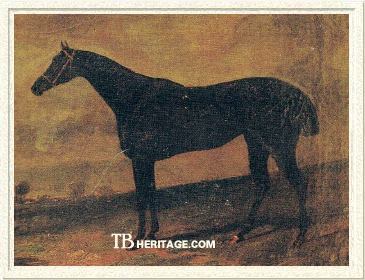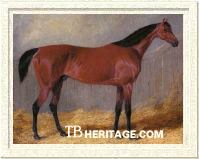|
|
Minuet

|
|
 |
|
|
Epsom Oaks winner Minuet was one of the many classic winners descended from Julia (1756, by Blank), the foundation mare in the stud of Augustus Henry FitzRoy, (3rd) Duke of Grafton. Julia's progeny populates almost all of Family 1, still the most prolific female line in thoroughbred history.
Minuet's dam, Woodbine (1791, by Woodpecker), was out of the Matchem mare, Puzzle, a grandaughter of Julia, making her in the fifth generation if horses bred in the Grafton studs at the Grafton seat, Euston Hall, in Suffolk, and the subsidiary hunting stud, Wakefield Lodge, in Northamptonshire, where both the 3rd Duke and his son, George Henry Fitzroy, the 4th Duke, had a significant impact on thoroughbred breeding through the Julia's descendants. Woodbine's female family did not extend much beyond Minuet, but her half-sister, Hornby Lass (1796, by Buzzard), a good race mare and broodmare, produced Oaks winner Morel (1805, by Sorcerer), who established many branches of Family 1.
In addition to Minuet, Woodbine produced six other foals. Her first was Miss Euston (1799, by Skyscraper), placed third of eight in Newmarket's July Stakes as a juvenile. Next came the filly Merrythought (1803, by Totteridge), and then Musician (1804, by Worthy). Musician was a high-class runner for the 3rd Duke, whose wins included the Prince's Stakes, the Newmarket Stakes and Claret Stakes at Newmarket. Musician was sold to the Marquis of Sligo and went to Ireland, where his primary contribution to the breed was as dam's sire of Skylark (1826, by Waxy Pope), the top earning racehorse in Ireland for three successive years, 1829-31, with forty career wins, and later a leading sire in Ireland in 1840.
Starting in 1808 Woodbine was bred exclusively to Epsom Derby winner Waxy, who had been acquired by the Graftons in 1807 after several years at stud for his breeder, Sir Fernandino Poole. Waxy had had a useful career before his purchase by the Duke of Grafton, but he became a huge influence on the stud book after he met the Grafton mares descended from Julia. He got the extremely significant stallions Whalebone and Whisker (both Derby winners), and numerous daughters that helped shape the thoroughbred.
Woodbine's first foal from this cross with Waxy was Handel (1809), who was purchased for 510 guineas by Lord George Cavendish when some of the 3rd Duke's stock were auctioned off in 1810. Handel won some races for Cavendish at Newmarket. Woodbine's next foal, her daughter Music (1810), won the Epsom Oaks for the 4th Duke, and was later sold to Ireland, where her line petered out. Music was followed by the 1811 filly Metre, and in 1812, her last foal, the bay Minuet, was born. Like all the Grafton horses that raced, Minuet was sent to Newmarket trainer Robert Robson.
Minuet on the Turf
At age two Minuet won the July Stakes at Newmarket, beating twelve other youngsters, both colts and fillies. At age three she was second to the Selim filly in the One Thousand Guineas, with two others in the field, and at the same meeting won 250 guineas, beating one other. At Epsom she won the Oaks, beating eleven. In the fall she won 250 guineas at Newmarket First October beating six others, and also received a forfeit for a scheduled match against Castanet. At Newmarket Houghton she was second to Cashew in the Newmarket Gold Cup, with six others in the field. She was unplaced twice that season.
In 1816 Minuet beat Fugitive in a 100 guineas match at Newmarket July, receiving seven pounds from the colt. At Chelmsford she took a walk-over for the King's Plate. At Newmarket in October she won the Trial Stakes, beating Discord, Perchance, and six others, and at the same meeting she beat Duenna in a match for 200 guineas, giving weight to Duenna. She did not place twice that year.
In 1817, age five, Minuet won the King's Plate at Newmarket, beating two, and at the same meeting ran second for a 50 sovereign purse to Rhoda, giving Rhoda more than a stone in weight. At Newmarket in October she did not place in the Trial Stakes, won by Bourbon, with six others in the field. She ran three other races that season, unplaced.
Minuet in the Stud
Minuet was retained by Grafton as a broodmare, but her record in the breeding shed was disappointing. Most of her produce raced and were winners, but none left much of a mark as bloodstock. She bred nine foals that survived to adulthood for the 4th Duke, plus twin fillies (1824), one of which died after four days and one at three months, and a colt by Saracen (1833) that died after two days. She was shot in April of 1833, not long after the birth of the colt that died.
Her first foal was BANQUO (1821, by Phantom), a winner at age three of Newmarket July's Town Plate and a sweepstakes at Newmarket, beating Epsom Derby winner Cedric.
BOLERO (1822, by Partisan) was a handsome bay. At age three he ran second to Enamel in the Two Thousand Guineas, and took the Grand Duke Michael Stakes (for three-year-olds) at Newmarket First October, beating Lionel Lincoln by a head with six others in the field, and following that with a sweepstakes for 100 guineas, beating three. He was used as a hunter by the 4th Duke, following the Grafton hounds, and based at Wakefield got a few runners, including Fox and Delapre (in-bred to Waxy), the latter a winner of Epsom's Woodcote Stakes for Lord Albemarle. Delapre (1841, out of Fortress, by Defence) was imported into Victoria, Australia by T. Chirnside in 1847. He was dam's sire of Hester Grazerook (1858, by The Premier - Miss Napier by Delapre), a south Australian colonial family that produced some south Australian classic winners and distance horses.
|

Bolivar
| |
BOLIVAR (1823, by Comus) was less distinguished; he won a 150 sovereign sweepstakes at Newmarket Craven in 1826, and was third in a sweepstakes at Newmarket First Spring, but then went unplaced in a fifty at Newmarket, in the Epsom Derby, and in a sweepstakes at Newmarket in June. In the fall he could only run third in the Grand Duke Michael Stakes. |
After dropping the twin fillies in 1824, she produced BRAMIN (1825, by Partisan), and the next year dropped his brother, BURMAN (1826). The GSB says both colts were sent to India in 1829, but BURMAN won a sweepstakes at Newmarket that year, and then was sold to the East India Company and shipped out -- whether to South Africa, India, or Australia not known -- in 1830.
Minuet's next foal, BRAMBILLA (1827), "a pretty creature, but small and slow," was her last by Partisan, who had been sold by Grafton the year before. At age three BRAMBILLA ran third in the One Thousand Guineas, then "cut a poor figure" in the Riddlesworth Stakes at Newmarket, and went unplaced in the Oaks, but beat Mouche in a sweepstakes over a mile at Newmarket. She did manage to win a sweepstakes at Ascot, and Newmarket's Trial Stakes in October.
BLASSIS (1828, by Emilius), another filly, ran unplaced five times for Grafton at age three, and was sold to Captain Martyn, who changed her name to MISTLETOE. At age four she won the Ladies Plate at St. Albans, beating eight other maidens. At Ascot she lost a match against Ida (by Whalebone) over a mile for 50 guineas. At Hampton she won the King's Plate, beating seven. At Chelmsford the good mare Lucetta beat her in the two-mile King's Plate, then she went on to win the Cup Stakes there, beating three. At Egham she was third and last in the Surrey and Middlesex Stakes, and at Rochester failed to place in the Rockingham Stakes. She producd ten foals, and several made it to the races, but it appears her line died out.
Minuet's 1829 unnamed filly by Merlin does not appear in the General Stud Book as a broodmare; a note after her entry under Minuet says she was shot in 1840. After a miss to Centaur and a slipped foal, Minuet produced BALANCE (1832, by Emilius), who appears briefly in a post match at Newmarket at age three, receiving a forfeit. BALANCE was retained for the Grafton stud, where she bred a few foals; one, an 1839 daughter by Ishmael, placed second in a small race at Newmarket. Her line, too, disappeared from the stud book.
-- Patricia Erigero
|
|
|
|

